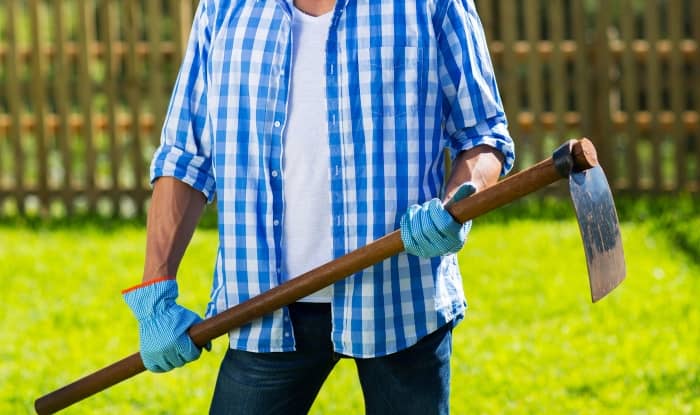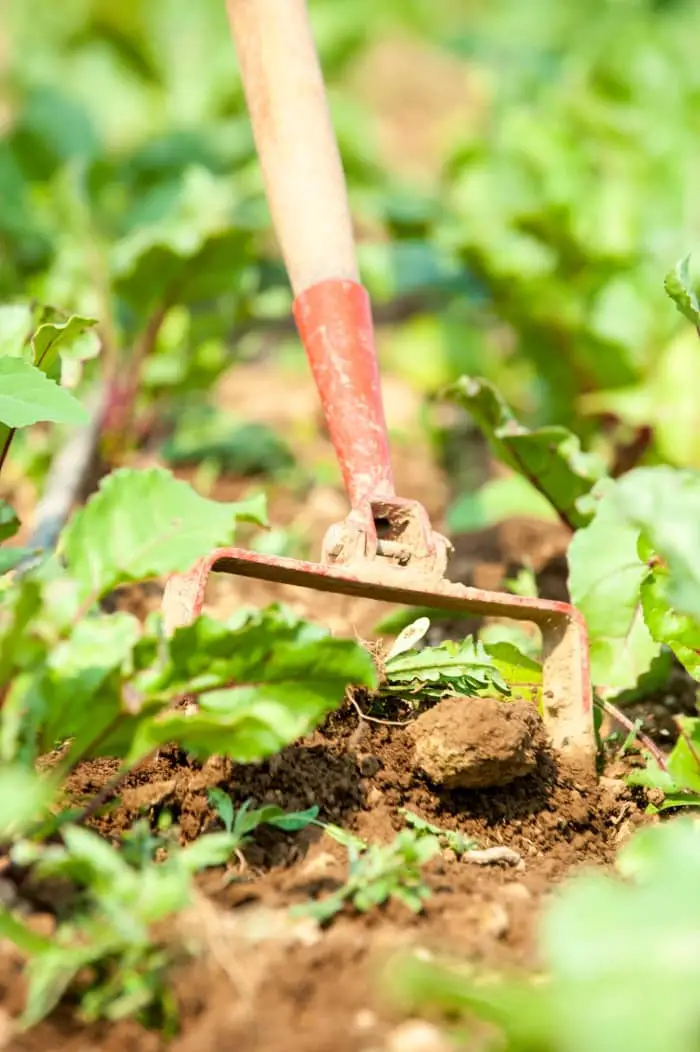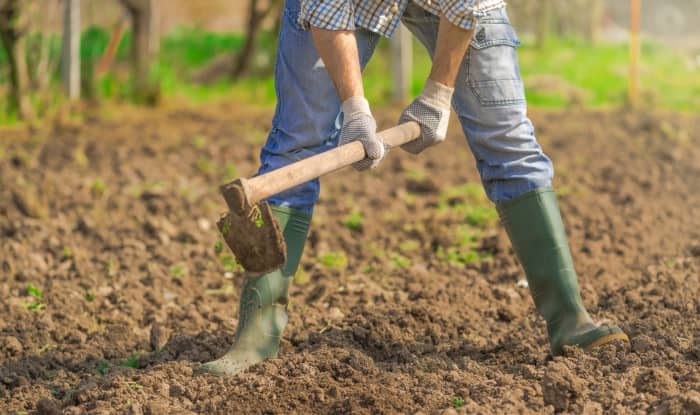A garden hoe is a very useful tool. Traditionally used in gardening and agriculture, it can help you quickly weed and cultivate the soil.
But before you can make full use of a hoe, you need to know how to use it correctly.
So in this article, we take a look at how to use a garden hoe for weeding, planting, and tilling.
Let’s dive in.
Choosing The Right Hoe For The Job
Before you get started, choose the best garden hoe for the job. Different types of hoes are best suited to different work.
Here are some of the most common types of hoe:
Stirrup Hoe
Also called a loop hoe, hula hoe, action hoe, or scuffle hoe. This type of hoe has a head that resembles a stirrup like you’d find attached to a saddle. You use a stirrup hoe for weed removal. You slide the blade of the stirrup hoe backward and forwards repeatedly just beneath the soil surface, cutting through weed stems.
The main advantage of using a stirrup hoe over a paddle hoe is that it causes less soil disturbance. So the soil dries out less, and fewer weed seeds reach the surface where they can germinate.
Related: Action Hoe vs Garden Hoe
Paddle Hoe
Also known as a draw hoe. A paddle hoe has a rectangular paddle at a 90-degree angle from its handle. A paddle hoe is one of the most commonly used garden hoes. It’s good for general gardening work as you can use it to dislodge and dig up weeds as well as moving and shaping the soil.
You use a paddle hoe by chopping into the ground and pulling the hoe towards you. You can also get smaller versions of the paddle hoe that are usable with one hand, making it easier to work in tight spaces.
Dutch Hoe
Also known as a push hoe, a Dutch hoe is well-designed for weeding. Rather than having a blade at a 90-degree angle, the Dutch hoe has a forward-facing blade. To use a Dutch hoe, you push and pull the tool with the blade just under the soil surface instead of chopping.
One of the advantages of a good Dutch hoe is that it’s easy to use while standing upright, placing less strain on your back while you work.
Collinear Hoe
Also called an onion hoe. This unique hoe has a sharp thin blade that lies flat on the soil. A collinear hoe is made for weeding, cutting weeds under the soil surface as you pull the blade towards you. This tool is easy to use in small spaces, and you can hoe without bending over, making it easy on your back.
Grub Hoe
Also known as a grubbing hoe, this type of hoe is mainly used for digging or tilling.
In hard soil, you can use a grub hoe for breaking the ground, allowing you to loosen and dig out the soil. This makes it easy to make room for planting trees or installing patio and paving stones.
Other uses of a grub hoe include mixing soft soil, digging trenches, and chopping through sod to help with removal.
Whichever type you decide to use, make sure you get a high-quality, heavy-duty hoe. Cheap models break easily and won’t last long.
How To Use A Garden Hoe
WEEDING HOE BY OREGON STATE UNIVERSITY
To make weed management easier, aim to use your garden hoe regularly. Wait until the soil is dry before hoeing. After heavy rain or watering soil becomes harder to move, and it can be more difficult to slide under the top layer of soil to cut weed stems from the roots.
How To Use A Garden Hoe For Weeding
- The best time to use your hoe is first thing in the morning.
- Wait until after you’ve used your garden hoe before watering the area.
- While using the hoe, stand as straight as you can to ease the strain on your back.
- Grip the hoe with both hands, similar to using a broom for sweeping.
- Push the blade of the hoe just under the soil surface.
- Push or pull (or both) the blade repeatedly to cut weeds down.
- You’ll often find it easier to use a short handle hoe if you’re working in tight spaces or for spot weeding.
How to Use A Garden Hoe To Sow Seeds
- Using the blade of a Dutch hoe or paddle hoe you can part the soil and create a shallow trench.
- Drop the seeds in the furrow that you’ve created.
- Use the hoe to cover the seeds with soil without bending down to the ground.
How Do You Till Soil With A Hoe?
For easier tilling, rear tine tillers are a good choice, especially if you have less strength or want to expend less effort.
- The best type of hoe to use for tilling is a grub hoe.
- Grip the hoe with one hand at the end of the handle nearest to your body and the other hand about a third of the way along it. Make sure your thumbs point towards the blade.
- Raise the hoe to chest or hip height, then swing the heavy-duty blade into the soil with a chopping motion. Keep your hands firmly on the handle without sliding them.
- Then pull the area of soil towards you using your whole body.
Tips For Using A Hoe
You can make it easier and more comfortable to use a garden hoe by following these tips:
Wear Gloves
Vigorous work with handled garden tools can cause discomfort and painful blisters. To protect your hands, you should get a good pair of garden gloves with reinforced palms and fingers and padding to give you a more comfortable grip.
Gloves will also protect you from scratches when picking up and disposing of prickly weeds.
Make sure the gloves are a comfortable fit. Having a closeable strap around the wrist helps to keep the gloves in place while you work, reducing friction.
It also helps if the gardening gloves are made from breathable material so your hands don’t get too hot and sweaty. Gripping material on the palms and fingers of the glove is another thing to look out for because it will help you maintain a better grip.
Switch Hands Regularly
To avoid overworking one side of your body, consider switching hands when you start to feel tired.
With a one-handed hoe, you can switch to your non-dominant hand whenever your dominant hand needs a rest. With a two-handed hoe, try switching the position of your hands to give your muscles a rest and reduce the risk of injury.
Posture And Form
Making sure you maintain the correct posture and form while using your hoe helps make the job easier and avoids injury.
Choose a two-handed hoe long enough that you don’t have to bend over while you work. To find a hoe with a comfortable length, choose one that reaches up to your armpit from the floor.
Work With The Weather
When using a hoe it’s best to work with the weather. It’s easier to use a hoe when the soil is dry. Turning the soil over and pushing and pulling the hoe blade beneath the soil surface are much harder when the soil is wet.
Wet soil is also prone to becoming compacted when you walk on it, making it harder for desirable plants to obtain water and oxygen and inhibiting root growth. Where you can, try to weed while standing on a pathway, patio stones, or gravel.
Use Your Hoe To Weed Regularly
It’s easiest to control weeds when they’re small and young before the plants develop thick stems and deep root systems. Regularly cutting weeds with your garden hoe each time they emerge from the soil will quickly exhaust the root system and kill the plant, preventing the weeds from spreading around your yard.
Scuffle hoes are a good choice for controlling young weeds. But for older, well-established weeds, you might find it easier with a paddle hoe or grub hoe, which can also dig roots from the ground.
Taking Care Of Your Hoe
If you want your hoe to give you many years of use, it’s important to look after it. Here are some maintenance tips:
- Clean the mud and dirt off your hoe after use.
- Use 80-grit sandpaper to scrub off any rust that starts to develop. You can also use boiled linseed oil to prevent the head of the tool from rusting.
- Sharpen your hoe periodically with a flat file or whetstone.
- If the hoe handle is wooden, periodically smooth it with sandpaper. Moisture causes it to roughen over time, but oil will protect it.




